Unit2-The-Olympic-Games-reading-(公开课)教学文案
- 格式:ppt
- 大小:6.14 MB
- 文档页数:3

Unit 2 Reading:The Olympic Games教案设计作者:胡亭王一珍来源:《中学生英语·教师版》2016年第10期I. Learning aims(1) During this lesson, students will learn some basic knowledge of the ancient and modern Olympic Games.(2) They will be able to master the new words and sentences in this passage.II. Teaching aims(1) Encourage the students to know something about the history of Olympic Games. Compare the ancient and modern ones.(2) Through reading, the students learn to grasp the detailed information of the text; their reading skills can be improved.III. Teaching methods(1) Fast reading to get the general idea of the passage.(2) Task-based reading, listening, speaking and writing.(3) Discussion and Pair work.IV. Teaching mediaBlackboard,Multi-mediaV. Teaching procedureStep 1 Lead inDo you know something important took place on August 8th, 2008 in Beijing of China? It was a great event about sports in the world. So many great players came to attend it. Eventually,China gold medals among all the countries that attended it. All of you have known it, yes or no?Yes, it was Olympic Games. Do you want to know something more about it? This text will lead you to enter a world about the ancient Olympic Games and modern ones. (PPT 1-5)(Purpose:通过2008年北京奥运会的一些图片引出话题,吸引学生注意力;导出阅读内容)【课前预习】Quiz about the Olympic Games (PPT 6-8)Step 2:自主学习、文章理解以及奥运常识A. Choose the best answer:(1) Do you know when the ancient Olympic Games began?A. In 1806.B. In 1900.C. In 776 BC.(2) What is the motto of the Olympics?A. Faster, Higher, StrongerB. Swifter, Longer, StrongerC. Farther, Higher, softerB. Remember these new words: compete, Olympic Games, event, motto, host,athlete, stadium, gold medal, horse-riding(Purpose:通过抢答,检查学生在预习后对课文的理解以及关于奥运会的常识,调动学生参与课堂的主观能动性。
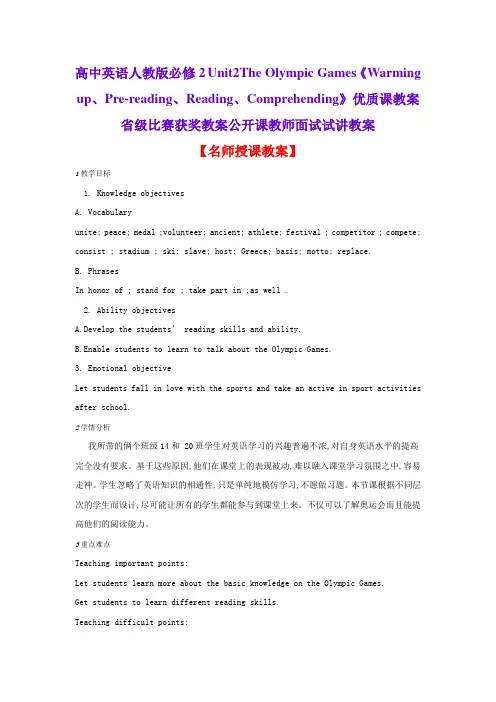
高中英语人教版必修2Unit2The Olympic Games《Warming up、Pre-reading、Reading、Comprehending》优质课教案省级比赛获奖教案公开课教师面试试讲教案【名师授课教案】1教学目标1. Knowledge objectivesA. Vocabularyunite; peace; medal ;volunteer; ancient; athlete; festival ; competitor ; compete; consist ; stadium ; ski; slave; host; Greece; basis; motto; replace.B. PhrasesIn honor of ; stand for ; take part in ;as well .2. Ability objectivesA.Develop the students’ reading skills and ability.B.Enable students to learn to talk about the Olympic Games.3. Emotional objectiveLet students fall in love with the sports and take an active in sport activities after school.2学情分析我所带的俩个班级14和 20班学生对英语学习的兴趣普遍不浓,对自身英语水平的提高完全没有要求。
基于这些原因,他们在课堂上的表现被动,难以融入课堂学习氛围之中,容易走神。
学生忽略了英语知识的相通性,只是单纯地模仿学习,不愿做习题。
本节课根据不同层次的学生而设计,尽可能让所有的学生都能参与到课堂上来。
不仅可以了解奥运会而且能提高他们的阅读能力。
3重点难点Teaching important points:Let students learn more about the basic knowledge on the Olympic Games.Get students to learn different reading skills.Teaching difficult points:。
![新人教版必修二 Unit 2 The Olympic Games-Reading1[课件]](https://uimg.taocdn.com/30672405581b6bd97f19ea9f.webp)
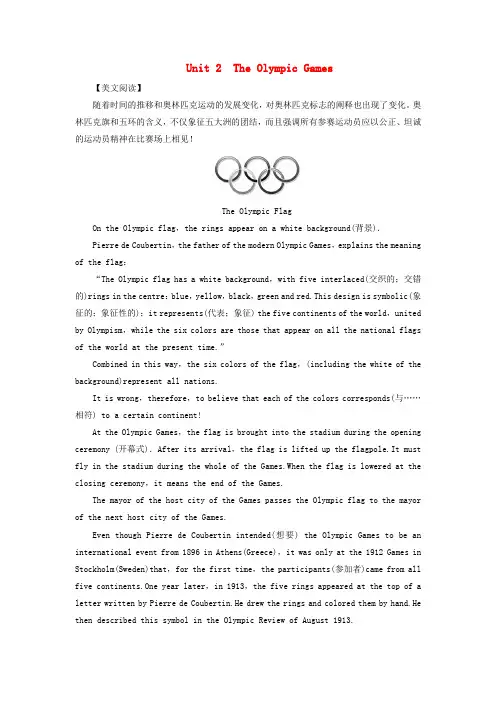
Unit 2 The Olympic Games【美文阅读】随着时间的推移和奥林匹克运动的发展变化,对奥林匹克标志的阐释也出现了变化。
奥林匹克旗和五环的含义,不仅象征五大洲的团结,而且强调所有参赛运动员应以公正、坦诚的运动员精神在比赛场上相见!The Olympic FlagOn the Olympic flag,the rings appear on a white background(背景).Pierre de Coubertin,the father of the modern Olympic Games,explains the meaning of the flag:“The Olympic flag has a white background,with five interlaced(交织的;交错的)rings in the centre:blue,yellow,black,green and red.This design is symbolic(象征的;象征性的);it represents(代表;象征) the five continents of the world,united by Olympism,while the six colors are those that appear on all the national flags of the world at the present time.”Combined in this way,the six colors of the flag,(including the white of the background)represent all nations.It is wrong,therefore,to believe that each of the colors corresponds(与……相符) to a certain continent!At the Olympic Games,the flag is brought into the stadium during the opening ceremony (开幕式).After its arrival,the flag is lifted up the flagpole.It must fly in the stadium during the whole of the Games.When the flag is lowered at the closing ceremony,it means the end of the Games.The mayor of the host city of the Games passes the Olympic flag to the mayor of the next host city of the Games.Even though Pierre de Coubertin intended(想要) the Olympic Games to be an international event from 1896 in Athens(Greece),it was only at the 1912 Games in Stockholm(Sweden)that,for the first time,the participants(参加者)came from all five continents.One year later,in 1913,the five rings appeared at the top of a letter written by Pierre de Coubertin.He drew the rings and colored them by hand.He then described this symbol in the Olympic Review of August 1913.It was also Coubertin who had the idea for the Olympic flag.He presented the rings and flag in June 1914 in Paris at the Olympic Congress.The First World War prevented the Games from being celebrated in 1916 in Berlin (Germany) as planned.It was not until 1920 in Antwerp (Belgium) that the flag and its five rings could be seen flying in an Olympic stadium.【诱思导学】1.Do you think why many countries want to host the Olympic Games,while others not?2.What contribution did Pierre de Coubertin make?【答案】 1.Reasons to host:a great honour;great responsibility and so on.Reasons not to host:too expensive;much planning;many stadiums and accommodation.2.He made the Olympic Games an international event.Period ⅠPreviewing(教师用书独具)●教学目标本课时主要是通过学生对学案所给出的内容的学习,了解本课文中所出现的词汇,初步了解课文以及相关的背景知识,对下一堂课对课文的全面理解起到一个铺垫作用。
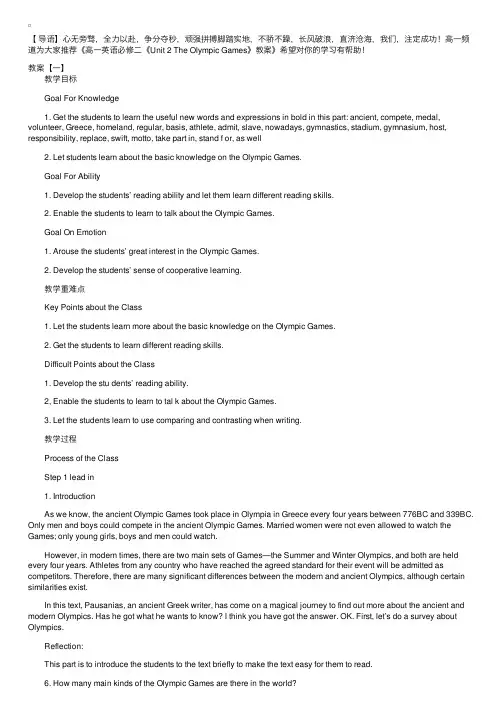
【导语】⼼⽆旁骛,全⼒以赴,争分夺秒,顽强拼搏脚踏实地,不骄不躁,长风破浪,直济沧海,我们,注定成功!⾼⼀频道为⼤家推荐《⾼⼀英语必修⼆《Unit 2 The Olympic Games》教案》希望对你的学习有帮助!教案【⼀】 教学⽬标 Goal For Knowledge 1. Get the students to learn the useful new words and expressions in bold in this part: ancient, compete, medal, volunteer, Greece, homeland, regular, basis, athlete, admit, slave, nowadays, gymnastics, stadium, gymnasium, host, responsibility, replace, swift, motto, take part in, stand f or, as well 2. Let students learn about the basic knowledge on the Olympic Games. Goal For Ability 1. Develop the students’ reading ability and let them learn different reading skills. 2. Enable the students to learn to talk about the Olympic Games. Goal On Emotion 1. Arouse the students’ great interest in the Olympic Games. 2. Develop the students’ sense of cooperative learning. 教学重难点 Key Points about the Class 1. Let the students learn more about the basic knowledge on the Olympic Games. 2. Get the students to learn different reading skills. Difficult Points about the Class 1. Develop the stu dents’ reading ability. 2, Enable the students to learn to tal k about the Olympic Games. 3. Let the students learn to use comparing and contrasting when writing. 教学过程 Process of the Class Step 1 lead in 1. Introduction As we know, the ancient Olympic Games took place in Olympia in Greece every four years between 776BC and 339BC. Only men and boys could compete in the ancient Olympic Games. Married women were not even allowed to watch the Games; only young girls, boys and men could watch. However, in modern times, there are two main sets of Games—the Summer and Winter Olympics, and both are held every four years. Athletes from any country who have reached the agreed standard for their event will be admitted as competitors. Therefore, there are many significant differences between the modern and ancient Olympics, although certain similarities exist. In this text, Pausanias, an ancient Greek writer, has come on a magical journey to find out more about the ancient and modern Olympics. Has he got what he wants to know? I think you have got the answer. OK. First, let’s do a survey about Olympics. Reflection: This part is to introduce the students to the text briefly to make the text easy for them to read. 6. How many main kinds of the Olympic Games are there in the world? 7. What is the motto of the Olympic Games? 8. What is the host city of the first Olympics? 9. What is the host city of the 2004 Olympics? 10. What is the host city of the 2008 Olympics? Suggested keys: 1-5 CBCDC 6. Two. They are the Summer Olympic Games and the Winter Olympic Games. 7. Higher, swifter and stronger. 8. Athens, Greece. 9. Athens, Greece. 10. Beijing, China. Reflection: This part is to arouse the interests of the students on Olympic Games and get them into the reading slowly. Step 2 Pre-reading Ask the students to look at the title of the text and the pictures in it and talk about them. 1) Title—An Interview An interview is a meeting in which someone is asking another one some questions in order to find out about their actions or opinions. 2) The first picture in the text The first picture is the statue of a great Greek. His name is Pausanias. He was a famous traveler and writer in the second century AD. 3) The second picture in the text The second picture is a Chinese athlete named Yang Yang. She won a gold medal for China at the 2002 Winter Olympic Games. She is a famous skating player. 4) The third picture in the text The third picture is the opening ceremony of the Olympic Games. Maybe this is the main stadium. It’s large and can hold thousands of audience. See in the sky the five white rings? They are the Olympic Five Rings which stand for the five continents—Asia, Africa, the Americas, Europe and Oceania. Reflection: This step is to help the students make a further understanding of the text. Step 3 Reading Comprehending 1 . Reading for the main idea What does the passage mainly tell about? Suggested answer: This text mainly tells about the similarities and the differences between the ancient and modern Olympic Games. 2. Reading for detailed information Ask the students to read this text carefully to locate detailed information and then choose the best answer. 1) Where do all the competitors live?A. A hotel.B. A special village.C. A restaurant.D. A place hired by competitors. 2) Why do many countries want to host the Olympic Games?A. To run faster, jumper higher and throw further.B. To get a great honour.C. To make the country famous.D. To make money. 3) Which of the following is included in the Winter Olympic Games?A. Skiing and ice skating.B. Running races.C. Horse riding.D. Swimming. 4) The last Olympic Games were held in _________.A. BeijingB. AtlantaC. AthensD. Sydney 5) Why does Pausanias think people may be competing for money in the modern Olympic Games? A. Because the winner can get medals. B. Because the winner can be awarded lots of money by their own countries. C. Because the olive wreaths have been replaced by medals. D. Because medals are made of gold. Suggested answers: 1)–5) BBACC Reflection: This part is to check if the students have truly understood the text. 3. Read the passage carefully and answer the following questions. 1) What amazes Pausanias about the Olympic Games? 2) Why does he think Athens and Beijing should feel proud? Keys: 1) Pausanias is amazed that many countries take part in the Olympics and women too and there are two sets of Olympics. 2) It’s a great honour to host the Olympics. Reflection: This part is to enable the students to have a deep understanding of the text by answering some difficult questions. Keys:1. one2. women; slaves3. Greece4. two5. reached; agreed standard 6. anywhere in the world Reflection: This part is to strengthen the key content in the text. 5. Summary writing 归纳写作 Answer these questions in not more than 100 words. 回答下列问题,将答案组成⼀个段落,不要超过100个单词。
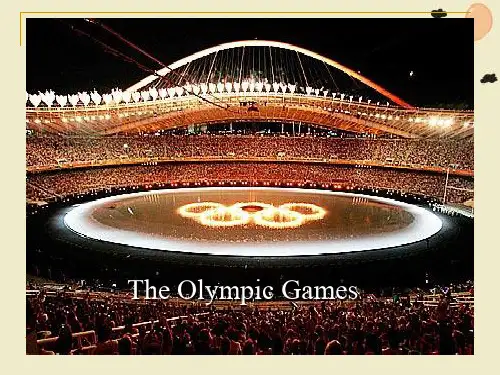

Unit-2-The-Olympic-Games教案(jiào àn)Unit-2-The-Olympic-Games教案(jiào àn)Unit 2 The Olympic GamesI.教学内容分析(fēnxī)本单元的中心(zhōngxīn)话题是“奥运会”。
Warming Up部分通过讨论让学生了解古代和现代(xiàndài)奥运会的异同。
Pre-reading部分的三个问题则进一步考查学生(xué sheng)对奥运会基本常识的了解。
Reading部分作者通过一个虚拟(xūnǐ)的采访向读者介绍了古代奥运会与现代奥运会的异同。
Comprehending部分帮助学生归纳他们已知的和刚学到的关于古代与现代奥运会异同,并且进一步讨论奥运会相关知识。
Learning about Language部分都同单元主题紧密相关,词汇和语法结构的呈现也尽可能地安排在相关的语境中。
Using Language部分通过一个希腊神话故事来引导学生进行读、听、说、写的综合训练。
Learning Tip部分鼓励学生在两人活动和小组活动中积极发言(fā yán),这样既可以消除害羞的心理,又有利于学生掌握恰当的交际策略。
II.教学重点(zhòngdiǎn)和难点1.教学(jiāo xué)重点(zhòngdiǎn)(1) 本单元的生词(shēngcí)和短语;(2)学会使用将来时的被动语态;(3)让学生熟悉奥运会—世界上最重要的体育盛会;能用英语就奥运会的基本知识进行互相问答,并能简述奥运会的基本知识;(4)鼓励学生表达自己的兴趣爱好,要多让学生讲自己熟悉的话题。
2.教学难点(1) 指导学生按类别归纳整理词汇,让学生学会有效的记忆词汇的方法;(2) 引导学生发现本单元重点语言结构,让学生自己发现并感悟相关的语言规律,培养他们的语感。
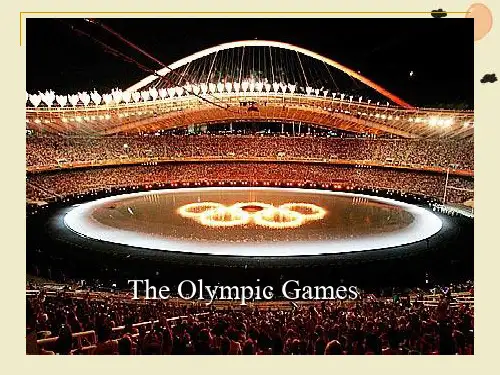
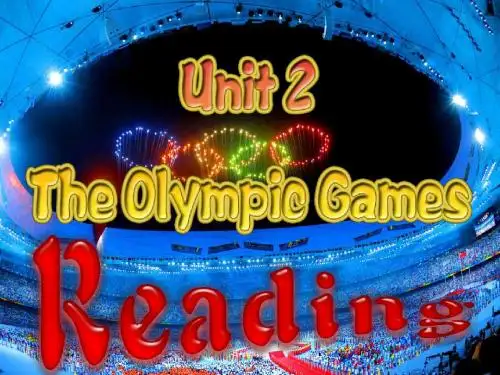
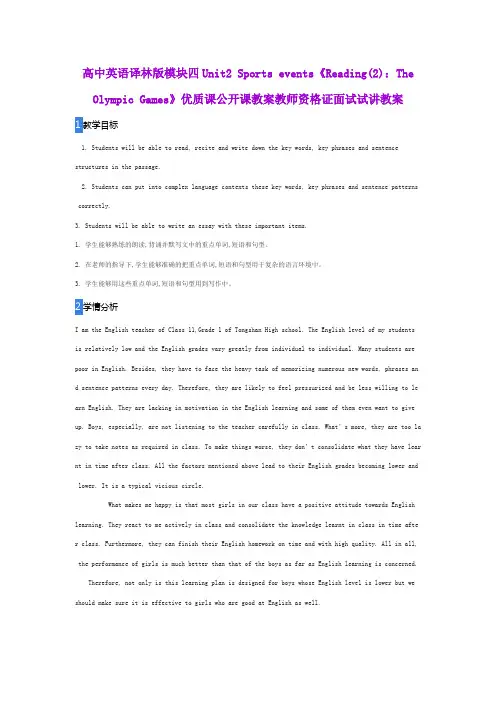
高中英语译林版模块四Unit2 Sports events《Reading(2):The Olympic Games》优质课公开课教案教师资格证面试试讲教案1教学目标1. Students will be able to read, recite and write down the key words, key phrases and sentence structures in the passage.2. Students can put into complex language contexts these key words, key phrases and sentence patterns correctly.3. Students will be able to write an essay with these important items.1. 学生能够熟练的朗读,背诵并默写文中的重点单词,短语和句型。
2. 在老师的指导下,学生能够准确的把重点单词,短语和句型用于复杂的语言环境中。
3. 学生能够用这些重点单词,短语和句型用到写作中。
2学情分析I am the English teacher of Class 11,Grade 1 of Tongshan High school. The English level of my students is relatively low and the English grades vary greatly from individual to individual. Many students are poor in English. Besides, they have to face the heavy task of memorizing numerous new words, phrases an d sentence patterns every day. Therefore, they are likely to feel pressurized and be less willing to le arn English. They are lacking in motivation in the English learning and some of them even want to give up. Boys, especially, are not listening to the teacher carefully in class. What’s more, they are too la zy to take notes as required in class. To make things worse, they don’t consolidate what they have lear nt in time after class. All the factors mentioned above lead to their English grades becoming lower and lower. It is a typical vicious circle.What makes me happy is that most girls in our class have a positive attitude towards English learning. They react to me actively in class and consolidate the knowledge learnt in class in time afte r class. Furthermore, they can finish their English homework on time and with high quality. All in all, the performance of girls is much better than that of the boys as far as English learning is concerned.Therefore, not only is this learning plan is designed for boys whose English level is lower but we should make sure it is effective to girls who are good at English as well.。
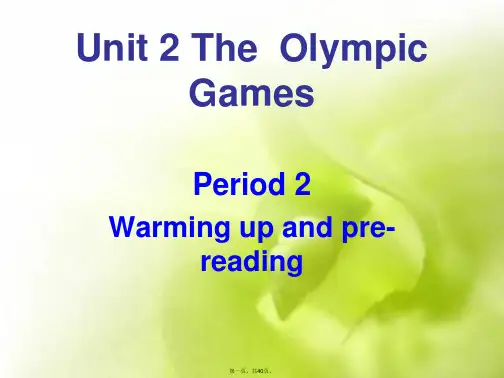
高一英语Unit2 The Olympic Games公开课教案Period 2 ReadingI. Teaching aims and demands1.Learn and master the new words and expressions in this period.2.Train the students’ reading and speaking ability.3. Train the students’ ability to use the Internet to sea rch for some useful information.4. Train the students’ ability to cooperate with others.II. Teaching important pointsTrain the students’ reading ability—skimming and scanning.III. Teaching difficult pointsDescribe the disasters.IV. Teaching aidsCAI, reading mp3V. Teaching proceduresStep1 Warming up1. Enjoy a video with a song which is to celebrate that Beijing win the right to host the 2008 Olympic Games to lead in the topic: the Olympic Games.2. Guessing game: Which number is concerned with the Olympic Games?five rings flagfive continentsThe five interlocking rings stand for friendship of five continents.Blue =Europe Black =Africa Red =America Yellow =Asia Green =Oceania3. Welcome to Beijing2008 Beijing Olympic Mascots4. the Olympic motto: Swifter, Higher, Stronger5. Summer Olympic eventsswimming, relay, gymnastics, weightlifting, tennis, table tennis, running, softball, diving, wrestling, volleyball, football, basketball, judo, pentathlon, javelin, high jump, long jump, marathon6. Winter Olympic eventsskating ,skiing, ski jumping, sledding, snowboarding(滑雪板运动), ice hockey(冰球)Step2 Pre-readingHow much do you know about the Olympic Games? Test your knowledge with this quiz.1.When and where did the ancient Olympic Games start?A. 776BC; in GreeceB. 776AD; in Greece2. What events were there in the ancient Olympic Games?A. Running, jumping, shooting, throwing, wrestling,B. Table tennis, jumping, volleyball, swimming3. When did the ancient Olympic Games stop?A. 393 ADB. 398AD4. When and where did the modern Olympics start?A. In 1896; in AthensB. In 1896; in America5. How many competitors from how many countrycompeted in 1896?A. There were 311 competitors from 13 countries.B. There were 1131 competitors from 113 countries.6. When did China first take part in the Olympic Games?A. In 1932B. In 19407. Who was China’s first gold medal winner and for w hat event?A. Xu Haifeng; shootingB. Xu Haifeng; table tennis8. How many competitors from how many country take part in the 27th Summer Olympics in Sydney?A.Over 10,000 athletes; 119 countriesB. Over 10,000 athletes; 184 countries9 .When did baseball become an Olympic sport?A. 1972B. 1992C.197610.Match the year and the host city of the following Summer Olympic Games.1984 2000 2004 2008Sydney Athens Beijing Los AngelesStep3 While-reading1. Fast reading : True or False.( )1. Men and women were allowed to take part in the ancient Olympic Games.( )2. The Winter Olympic Games are held every three years.( )3. The 28th Olympic Games will be held in Beijing.( )4. A special village is built for competitors to live in.( )5. To hold the Olympic is a rich prize and a big honor for a country.2. Careful readingTell the difference between ancient and modern Olympics according to the reading passage.Name The ancient Olympics The modern OlympicsTime every four yearsPlace in GreecePeople men and womenGames only summer gamesPrizes Olympic medalsBeliefs The same Olympic motto1. Pausanias was__________.A. a writer who lived in “Ancient Greece”B. an English writer 2,000 years ago.C. a writer who wrote about the modern Olympic Games.D. an athlete2. Who could take part in the ancient Olympics in Greece?A. Greek nobles(贵族)B. Greek slaves.C. Greek womenD. English nobles3. Who can be admitted to the present Olympic Games?A. All the athletes from all over the world.B. Athlete from the developed countries.C. Athletes who can reach the required standard.D. Athletes from the Greek cities.4. When will the next Winter Olympics be held?A. 2006B.2007C. 2008D. 20095. Which of the following statements is TRUE?A. Pausanias wasn’t interested in the Olympics.B. It is easy to win the right to host the Olympics.C. Almost every country wants to host the Olympics.D. It costs little to host the Olympics.Step5 Questions1.What upsets Pausanias about modern Winter Olympic Games?2.What amazes Pausanias about the modern Summer Olympic Games?3.Whe does Pausanias think Athens, Greece and Beijing, China should feel proud?4.Why does Pausanias think people may be competing for money in the modern Olympic Games?5.What makes Pausanias happy about the modern Olympic Games?Step6 DiscussionWhat can we do for the 2008 Olympics?1.Encourage ourselves and other Chinese to plant more trees and grass.2.Have good manners in public so as to leave a good impression on foreigners3.have a good knowledge of English and encourage the public speak English widely4.Be V olunteers to be guides for foreigners5.Learn the spirit of the Olympic Games and regard its motto as life and study mottoStep7 HomeworkFind out and underline the important language points in this unit.Finish the Workbook reading exercises.Prepare for the next period.。